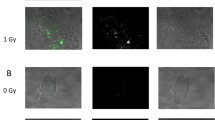Abstract
THERE is almost no information on the mutagenic effectiveness of the various ionising radiations for man and only limited information about radiations other than X or γ rays for experimental mammals. We have measured inactivation and mutation induction in cultured mammalian cells exposed to various radiations covering a range of linear energy transfer (LET; ref. 1). We show for two cell types that the maximum mutagenic effectiveness of these radiations, relative to X or γ rays, is about twice that for inactivation. Preliminary experiments suggest that specific chromosome aberrations may be associated with mutations induced by radiations of high LET.
Similar content being viewed by others
References
International Commission on Radiation Units and Measurements, Rep. 16 (1970).
International Commission on Radiological Protection, Publ. 18 (Pergamon, Oxford 1972).
Searle, A. G. Adv. Radiat. Biol. 4, 131–207 (1974).
Thacker, J. & Cox, R. Nature 258, 429–431 (1975).
Cox, R., Thacker, J. & Goodhead, D. T. Int. J. Radiat. Biol. (in the press).
Howard-Flanders, P. Adv. biol. med. Phys. 6, 553–603 (1958).
Brusted, T. Adv. biol. med. Phys. 8, 161–224 (1962).
Barendsen, G. W. Curr. Top. Radiat. Res. 4, 293–356 (1968).
Neary, G. J. Int. J. Radiat. Biol. 9, 477–502 (1965).
Munson, R. J., Neary, G. J., Bridges, B.A. & Preston, R. J. Int. J. Radiat. Biol. 13, 205–224 (1967).
Munson, R. J. & Bridges, B. A. Int. J. Radiat. Biol. 24, 257–273 (1973).
Leenhouts, H. P. & Chadwick, K. H. 4th Symp. Microdosimetry, Verbania Pallanza, Italy, 1973 EUR 5122 (1974).
Thacker, J., Stretch, A. & Stephens, M. A. Mutat. Res. 42, 313–326 (1977).
Cox, R. & Masson, W. K. Mutat. Res. 37, 125–136 (1976).
Russell, L. B. Mutat. Res. 11, 107–123 (1971).
Brown, J. A. et al. Cytogenet. Cell Genet. 16, 54–59 (1976).
Sumner, A. T., Evans, H. J. & Buckland, R. A. Nature new Biol. 232, 31–32 (1971).
Munson, R. J. & Goodhead, D. T. Mutat. Res. 42, 145–160 (1977).
Recommendations of the International Commission on Radiological Protection, Publ. 15, (Pergamon, Oxford, 1970).
Cox, R., Masson, W. K. & Bance, D. A. Lab. Practice 22, 733–734 (1973).
Thacker, J., Stephens, M. A. & Stretch, A. Mutat. Res. 35, 465–478 (1976).
Neary, G. J. in The Uses of Cyclotrons in Chemistry, Metallurgy and Biology (ed. Amphlett, C. B.) 194–203 (Butterworth, London, 1970).
Cox, R., Masson, W. K. & Bance, D. A. Mutat. Res. 35, 173–178 (1976).
Cox, R. & Masson, W. K. Mutat. Res. 36, 93–104 (1976).
Author information
Authors and Affiliations
Rights and permissions
About this article
Cite this article
Cox, R., THACKER, J., GOODHEAD, D. et al. Mutation and inactivation of mammalian cells by various ionising radiations. Nature 267, 425–427 (1977). https://doi.org/10.1038/267425a0
Received:
Accepted:
Issue Date:
DOI: https://doi.org/10.1038/267425a0
- Springer Nature Limited
This article is cited by
-
DNA damage interactions on both nanometer and micrometer scale determine overall cellular damage
Scientific Reports (2018)
-
Distinct transcriptome profiles identified in normal human bronchial epithelial cells after exposure to γ-rays and different elemental particles of high Z and energy
BMC Genomics (2013)
-
The Fate of a Normal Human Cell Traversed by a Single Charged Particle
Scientific Reports (2012)
-
Effect of gene dosage on cell-surface expression of Thy-1 antigen in somatic cell hybrids between Thy-1− abelson-leukemia-virus induced lymphomas and Thy-1+ mouse lymphomas
Immunogenetics (1981)
-
Induction of micronuclei in bean roots by 250 GeV hadrons
Radiation and Environmental Biophysics (1981)





